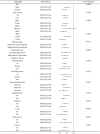Association of socioeconomic status and overactive bladder in US adults: a cross-sectional analysis of nationally representative data
- PMID: 38596511
- PMCID: PMC11003547
- DOI: 10.3389/fpubh.2024.1345866
Association of socioeconomic status and overactive bladder in US adults: a cross-sectional analysis of nationally representative data
Abstract
Background: Socioeconomic status inequality is an important variable in the emergence of urological diseases in humans. This study set out to investigate the association between the prevalence of overactive bladder (OAB) and the poverty income ratio (PIR) that served as a more influential indicator of socioeconomic status compared to education and occupation.
Method: Data from the National Health and Nutrition Examination Survey (NHANES) conducted from 2007 to 2020 were used in this cross-sectional study. The association between the PIR and OAB was examined using weighted multivariate logistic regression and weighted restricted cubic splines (RCS). Additionally, interaction analysis was used for investigation to the connections between PIR and OAB in various covariate groups in order to confirm the stability of the results.
Results: We observed a noteworthy inverse association between PIR and OAB after adjusting for potential confounding variables (OR = 0.87, 95% CI, 0.84-0.90, p < 0.0001). PIR was transformed into categorical variables, and the association held steady after that (1.0 < PIR <4.0 vs. PIR ≤ 1.0, OR = 0.70, 95% CI =0.63-0.77, p < 0.0001; PIR ≥ 4.0 vs. PIR ≤ 1.0, OR = 0.56, 95% CI =0.48-0.65, p < 0.0001). Additionally, RCS analysis showed that PIR and OAB had a negative nonlinear response relationship. Subgroup analyses showed that the inverse association between PIR and prevalence of OAB was stronger in obese than in nonobese individuals (P for interaction < 0.05).
Conclusion: In our study, we observed a significant negative association between the PIR and the prevalence of OAB. In the future, PIR could be used as a reference standard to develop strategies to prevent and treat OAB.
Keywords: NHANES; nocturia; overactive bladder; poverty income ratio; socioeconomic status.
Copyright © 2024 Lin, Li, Xu, Chen, Zheng, Hong and Liu.
Conflict of interest statement
The authors declare that the research was conducted in the absence of any commercial or financial relationships that could be construed as a potential conflict of interest.
Figures



Similar articles
-
Global Prevalence of Overactive Bladder: A Systematic Review and Meta-analysis.Int Urogynecol J. 2025 Feb 14. doi: 10.1007/s00192-024-06029-2. Online ahead of print. Int Urogynecol J. 2025. PMID: 39951109 Review.
-
Associations between exposure to organophosphate esters and overactive bladder in U.S. adults: a cross-sectional study.Front Public Health. 2023 Nov 9;11:1186848. doi: 10.3389/fpubh.2023.1186848. eCollection 2023. Front Public Health. 2023. PMID: 38026372 Free PMC article.
-
The association between urinary cadmium exposure levels and overactive bladder syndrome in the U.S. adults from NHANES database.Sci Rep. 2025 Apr 15;15(1):12870. doi: 10.1038/s41598-025-97012-4. Sci Rep. 2025. PMID: 40234603 Free PMC article.
-
Association between weight-adjusted waist index and overactive bladder syndrome among adult women in the United States: a cross-sectional study.BMC Womens Health. 2024 Sep 4;24(1):488. doi: 10.1186/s12905-024-03339-x. BMC Womens Health. 2024. PMID: 39232696 Free PMC article.
-
Atherogenic Index of Plasma mediates the association between Life's Crucial 9 with overactive bladder: a secondary data analysis from NHANES.Front Endocrinol (Lausanne). 2025 Feb 28;16:1505712. doi: 10.3389/fendo.2025.1505712. eCollection 2025. Front Endocrinol (Lausanne). 2025. PMID: 40093745 Free PMC article.
Cited by
-
Association of weight-adjusted waist index (WWI) with overactive bladder (OAB): a cross-sectional study from NHANES 2005-2018.Sci Rep. 2025 Apr 16;15(1):13207. doi: 10.1038/s41598-025-98050-8. Sci Rep. 2025. PMID: 40240487 Free PMC article.
-
The association between education level and overactive bladder: Evidence from a U.S. population-based study.Prev Med Rep. 2024 Oct 10;47:102898. doi: 10.1016/j.pmedr.2024.102898. eCollection 2024 Nov. Prev Med Rep. 2024. PMID: 39493504 Free PMC article.
-
Association of overactive bladder with red cell distribution width to albumin ratio in American.Sci Rep. 2025 Jul 28;15(1):27395. doi: 10.1038/s41598-025-13129-6. Sci Rep. 2025. PMID: 40721625 Free PMC article.
-
Global Prevalence of Overactive Bladder: A Systematic Review and Meta-analysis.Int Urogynecol J. 2025 Feb 14. doi: 10.1007/s00192-024-06029-2. Online ahead of print. Int Urogynecol J. 2025. PMID: 39951109 Review.
-
Health utility value of overactive bladder in Japanese older adults.BJUI Compass. 2024 Nov 24;6(1):e471. doi: 10.1002/bco2.471. eCollection 2025 Jan. BJUI Compass. 2024. PMID: 39877574 Free PMC article.
References
-
- National Research Council . Measuring poverty: A new approach. Citro CF, Michael RT, editors. Washington, DC: The National Academies Press; (1995). Available at: www.nap.edu/catalog/4759/measuring-poverty-a-new-approach (Accessed April 24, 2020).
MeSH terms
LinkOut - more resources
Full Text Sources
Medical

